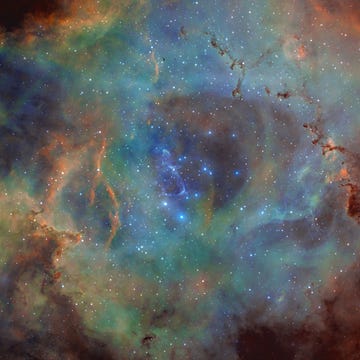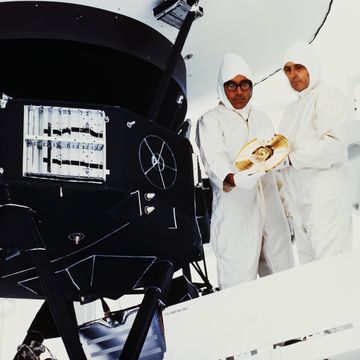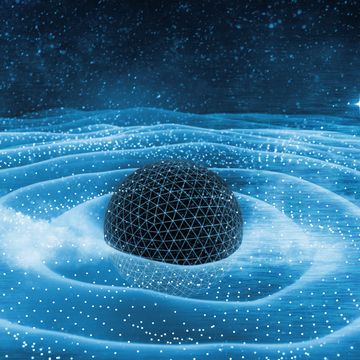- Traversable wormholes may be more than science fiction, new research suggests.
- Two separate studies published in Physical Review Letters D propose new theories for how to construct a traversable wormhole.
- Wormholes, also known as Einstein-Rosen bridges, are commonly used in sci-fi stories as a way to quickly zip between distant parts of the universe.
Sci-fi writers have long leaned on the wormhole as an important plot device. It’s a quick way to get characters from Point A to Point B across vast distances in spacetime in a matter of seconds. But are wormholes real?
🐛 You love weird science. So do we. Let’s nerd out over it together.
Theorists like Albert Einstein and Kip Thorne have been pondering the existence of these spacetime portals for decades, but so far, no one has been able to provide physical evidence of their existence until recently.
Two March 2021 studies, published in the journals Physical Review Letters and Physical Review D, propose wormholes safe enough for humans to travel through could exist in the real world after all. A third study published to the preprint server arXiv in September 2021 considers using a slightly different concept of gravity to allow safe passage through a wormhole.
One of the main arguments against the existence of wormholes suggests the portal’s narrowest part, or neck, would likely collapse under the weight of its own gravity. Some theorists say one way to sidestep this issue and prevent gravitational collapse would be to fill the wormhole with an exotic form of matter that has negative mass. But this solution isn’t a cosmological silver bullet—such a form of matter is purely theoretical.
In the first paper, an international trio of researchers led by Jose Blázquez-Salcedo of the Complutense University of Madrid has proposed an alternative way to prevent the collapse of a fragile wormhole’s neck—one that doesn’t need exotic matter to keep the wormhole propped open.
Instead, the researchers’ theoretical models, which ponder the possibility of microscopic wormholes, draw from three theories to harness the power of elementary particles: relativity theory, quantum theory, and electrodynamics.
These scientists suggest tweaking the mass and charge of fermions—fundamental building blocks of matter—could keep the cosmic thruway open. This would only work if the ratio of the total charge of the fermions to the total mass of everything inside the wormhole is greater than the practical limit set by black holes.
Now, there’s a catch: Blázquez-Salcedo and his team are talking about microscopic wormholes. They’re not exactly traversable by humans, but this is certainly one small step in a new theoretical direction.
The second paper, however, which comes from Juan Maldacena of the Institute for Advanced Study in New Jersey and Alexey Milekhin from Princeton University, does explore the theoretical existence of wormholes large enough for spacetime-surfing humans to squeeze through.
In this case, Maldacena and Milekhin have devised a wormhole that forms in five-dimensional spacetime, also known as the Randall-Sundrum model. These wormholes would look like intermediate-mass black holes to the untrained observer, the authors say.
If you hopped in this kind of wormhole, you’d experience up to 20 Gs of acceleration—an uncomfortable, albeit survivable, amount. But the authors acknowledge some practical limitations with this theory. For example, the wormhole has to be extremely clean—i.e., free from errant particles:
If particles that fall into the wormhole scatter and lose energy then they would accumulate inside, contributing some positive energy that would eventually make the wormhole collapse back into a black hole.
The last place anyone traveling through space wants to end up is at the center of a black hole. The wormhole also has to be extremely cold, the researchers write. And then there’s the small problem of actually generating the wormhole in the first place. Maldacena and Milekhin are still working on figuring out how to form one.
Needing negative energy or negative mass (exotic matter, in other words) to construct your wormhole is too much trouble. Instead, you need to tweak your understanding of gravity, according to João Luís Rosa, a physicist at University of Tartu, in Estonia. His paper on the arXiv preprint server discusses the use of a model called “generalized hybrid metric-Palatini gravity.” This concept is based on general relativity, but matter and energy, and space and time, have slightly different relationships than those predicted by general relativity. So, you would be able to build a stable wormhole by layering the entrance with double thin shells of regular matter—no exotic matter needed.
After all this fact-or-fiction speculation, what’s the good news? Theoretically, your cross-galaxy trip would only take less than a second. But if your family and friends are tracking your journey from outside the wormhole, they’ll be waiting a long time for it to end. From their perspective, your trip would last tens of thousands of years.
Looks like you’ll have to find your own ride home.
Correction, March 12, 2021: A previous version of this article mistakenly clipped short a quote from the article “Humanly traversable wormholes.” We regret the error.
Jennifer Leman is a science journalist and senior features editor at Popular Mechanics, Runner's World, and Bicycling. A graduate of the Science Communication Program at UC Santa Cruz, her work has appeared in The Atlantic, Scientific American, Science News and Nature. Her favorite stories illuminate Earth's many wonders and hazards.













